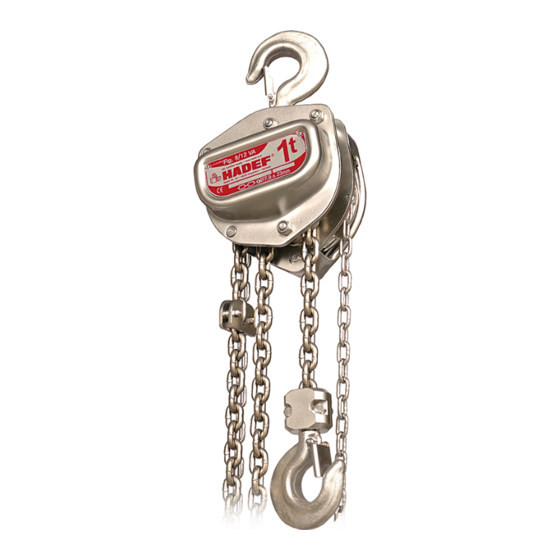
Summary of Contents for HADEF 9/12-VA
- Page 1 Installation,- Operating and Maintenance Instructions HADEF Spur Gear Hoist Type 9/12-VA 5.52.194VA.00.01.03 Rev.03...
-
Page 2: Table Of Contents
Heinrich de Fries GmbH Heinrich de Fries GmbH, Gauss Str. 20, D-40235 Düsseldorf Heinrich De Fries GmbH will be named HADEF in the following text. Original operating- and maintenance instructions in German language. Translation in other languages is made of the German original. -
Page 3: Information
11.1 General ..........................10 11.2 Monitoring ........................10 11.3 Replacing the load chain ....................11 Inspection ..................11 12.1 Periodic checks ....................... 11 12.2 Checking the load chain ....................12 12.3 Checking the load hook ....................12 12.4 Check of the pawl ...................... -
Page 4: Safety
Failure to follow the instructions of this manual can lead to unpredictable hazards. For any resulting damage or personal injury, HADEF assumes no liability. The unit was designed and built following a risk analysis and careful selection of the harmonized standards that are to be complied with, as well as other technical specifications. -
Page 5: Requirements For The Operating Personnel
The permitted environmental temperature during equipment operation is –20°C up to +40°C. Defective devices and load suspension devices must not be used until they have been repaired! Only original spare parts must be used. Non-compliance will result in any warranty claims on HADEF becoming void. -
Page 6: Transport And Storage
Supporting structures and load-attached devices used in conjunction with this equipment must provide an adequate safety factor to handle the rated load plus the weight of the equipment. In case of doubt, consult a structural engineer. If the equipment has not been used for a period of time, carry out visual checks of all main components such as chains, load hooks etc. -
Page 7: Safety Device For Transport
Safety device for transport NOTICE! Should a safety device for transport exist, please remove it before commissioning. Storage Store the equipment at a clean and dry place. Protect the equipment against dirt, humidity and damage by an appropriate cover. Protect hooks, wire ropes, chains and brakes against corrosion. Description Areas of application The devices must be as far as possible installed in a covered room. -
Page 8: Technical Data
In case of ex proof hoists, the housing is only made of steel plates. Load chain According to EN 818-7-T high quality chain. All components match precisely to each other. Therefore please only use original chains. Load hook Forged steel. Rotating, this facilitates attaching the load and avoids twisting of the chain. With safety catch. Overload protection Hoists with overload protection protects the hoist by a slipping clutch from damage by overload. -
Page 9: Brake And Pawl
NOTICE! For double lifting mechanism Operate both lifting mechanism, synchronous resp.evenly. CAUTION! Run in of chain into the chain container for hoist with double lifting mechanism For a correct run in of chain into both chain containers, the lowering operation must be carried out, without load, at certain intervals, until both chain container are empty. -
Page 10: Load Chain
Load chain Before commissioning the load chain must be aligned and oiled. For the first commissioning of motorized hoists, chain oil is supplied with the delivery. Move safety note and fixing wire away from the chain. CAUTION! Do not use grease for lubrication of load chain. Without lubrication, manufacturer's warranty and/or liability will be void. -
Page 11: Replacing The Load Chain
11.3 Replacing the load chain CAUTION! If there is any visible damage and when the conditions for replacement are reached (i.e. one or several dimensions in the table have been reached, there is corrosion or elongation), the chain must be replaced. When replacing the chain, also check the chain wheels. -
Page 12: Checking The Load Chain
12.2 Checking the load chain CAUTION! The load chain must be tested over its entire length! The measure of the load chain must be carried out especially in the areas which are subject to the highest wear. Through the lifting movement, these are the contact points of the chain with sprocket wheel and deflection pulleys. -
Page 13: Check Of The Pawl
12.4 Check of the pawl Vmin 28,5 1000 31,5 2000 31,5 3000 31,5 12.5 Check of the brake system Ratchet wheel (A) and brake linings (B) Vmin tv min 1000 92,5 91,5 2000 92,5 91,5 3000 12.6 Check of suspension and load hook bolts Suspension bolt dv min 11,5... -
Page 14: Load Hook
Recommendation Interval oil for example: FUCHS RENOLIN PG 220 or special chain lubricant Load chain 0,2 l 3 month Use NO grease! CAUTION! Do not use grease for lubrication of load chain. Without lubrication, manufacturer's warranty and/or liability will be void. 13.2 Load hook Check bearings and pulleys yearly... -
Page 15: Lubricant For Food Industry - Selection (As Option*)
13.7 Lubricant for food industry – Selection (as option*) KLÜBER SHELL MOBIL CASTROL Gearing FM Grease HD2 Mobilgrease FM 222 Klüberoil 4UH 1-1500 N Load chain Optimol Viscoleb 1500 Lubricant FM 100 Load hook; Pulleys FM Grease HD2 Mobilgrease FM 222 Gear rim;... -
Page 16: Decommissioning
Decommissioning WARNING! It is essential that the following points are observed in order to prevent damage to the equipment or critical injury when the device is being decommissioned: It is mandatory that all steps for decommissioning the machine are carried out in the indicated sequence: First secure the working area for decommissioning, leaving plenty of space.
















Need help?
Do you have a question about the 9/12-VA and is the answer not in the manual?
Questions and answers